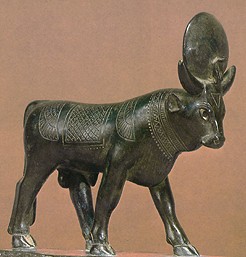
A sacred bull worshipped in Egypt from as early as the Predynastic Period. Various classical authors provide a great deal of information, not all of it reliable. Only one Apis bull at a time was worshipped in Egypt. Its choice was determined by the presence of certain physical characteristics, 29 in total according to some classical authors, a number that was influenced by the 29 days of the lunar cycle (the Apis had a certain relationship with this celestial body). Among the most important physical characteristics was a white triangle on the forehead and black markings on the body, one of which had to be shaped like an eagle, according to Herodotus. The Apis originated in Memphis, and was linked to the god Ptah. More precisely, the Apis was interpreted as the Ba of Ptah. Perhaps because of the union Ptah-Sokar-Osiris, the Apis was linked with Osiris. This god, also called 'the great bull of the west', was a provider of fertility, as was the Apis. The Pyramid Texts from the Old Kingdom already mention the Apis in connection with his fertility, a motif that returns in Diodorus Siculus who relates that women used to hitch up their skirts in front of the Apis. The relationship Osiris-Apis was so close that in the Graeco-Roman Period a new god was created, Sarapis (= Osar-Apis). The Apis also had solar features, as indicated by the sun disk depicted in between his horns from the New Kingdom on, and by his relationship with the god Atum. The Apis bull lived in the so-called Apieion near the temple of Ptah at Memphis, according to Herodotus. Here he was revealed to the populace and his movements interpreted as oracles. The bull was also on show during festival processions. This 'Apis walk' is known from earliest times. The aim was to give fertility to the fields. Within the framework of his role as a mortuary god, the Apis walk, as depicted on the foot ends of many Late Period sarcophagi, served to carry the deceased to the tomb. After the Apis bull itself died, it was mummified and buried in the Serapeum. Part of the mummification ritual for the Apis bulls has been preserved in a Demotic papyrus, now in Vienna.